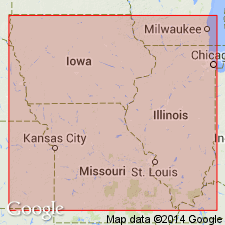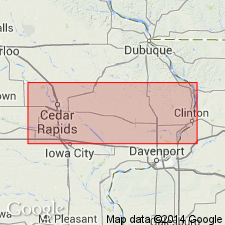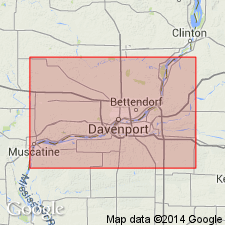
- Usage in publication:
-
- Anamosa limestone
- Modifications:
-
- Named
- Dominant lithology:
-
- Limestone
- Dolomite
- AAPG geologic province:
-
- Iowa shelf
Summary:
Name Anamosa limestone applied to earthy, finely and perfectly laminated dolomite not highly crystalline, forming top member of Niagara formation in eastern IA. Overlies LeClaire limestone. Age is Silurian.
Source: GNU records (USGS DDS-6; Reston GNULEX).

- Usage in publication:
-
- Anamosa Member
- Modifications:
-
- Revised
- Areal extent
- AAPG geologic province:
-
- Iowa shelf
- Wisconsin arch
Summary:
Anamosa stage of Calvin (1896) given formal status as Anamosa Member of Gower Formation. Type locality designated at Stone City, 2.5 mi west of Anamosa. Thickness at type 87 ft; maximum 150 ft. Consists of laminated dolomite quarrystone and dense dolomite. Recognized in Jackson and Caroll Cos., IL. Authors suggest that Racine in IL be replaced in part by Gower Formation. Anamosa interfingers with Brady and LeClaire Members. Overlies Scotch Grove Formation. Age is Late Silurian.
Source: GNU records (USGS DDS-6; Reston GNULEX).

- Usage in publication:
-
- Anamosa Member
- Modifications:
-
- Areal extent
- Overview
- AAPG geologic province:
-
- Iowa shelf
- Wisconsin arch
Summary:
One of author's primary aims in this report is to strongly encourage adoption of IA nomenclature in adjacent IL. The only major change is the incorporation of the Sweeney and Marcus as members within the Hopkinton and replacement of the Racine with upper members of the Hopkinton, the Scotch Grove Formation, and the Gower Formation. The Gower is over 150 ft thick in the Quad Cities area. The dominant facies is the Anamosa Member, which is characterized by flat-lying laminated dolomite. The eastward extent of the Anamosa strata in IL is not known with certainty, but the study area is probably the eastern limit. Laminated Anamosa strata interbed complexly with the LeClaire Member in the Quad Cities area. The LeClaire represents complex carbonate mound and bank facies. The name LeClaire has been used in the area since 1858 and has clear stratigraphic precedence over any subsequent term applied to equivalent strata in the area, including the Port Byron and Racine Formations. The Gower unconformably underlies the Middle Devonian Wapsipinicon Group or Pennsylvanian shale or sandstone. The Gower is approximately mid-Wenlockian in age at its base, and may be Ludlovian in its upper part.
Source: GNU records (USGS DDS-6; Reston GNULEX).
For more information, please contact Nancy Stamm, Geologic Names Committee Secretary.
Asterisk (*) indicates published by U.S. Geological Survey authors.
"No current usage" (†) implies that a name has been abandoned or has fallen into disuse. Former usage and, if known, replacement name given in parentheses ( ).
Slash (/) indicates name conflicts with nomenclatural guidelines (CSN, 1933; ACSN, 1961, 1970; NACSN, 1983, 2005, 2021). May be explained within brackets ([ ]).

